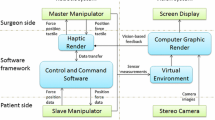Abstract
To evaluate the operation comfortability in the master-slave robotic minimally invasive surgery (MIS), an optimal function was built with two operation comfortability decided indices, i.e., the center distance and volume contact ratio. Two verifying experiments on Phantom Desktop and MicroHand S were conducted. Experimental results show that the operation effect at the optimal relative location is better than that at the random location, which means that the optimal function constructed in this paper is effective in optimizing the operation comfortability.
Similar content being viewed by others
References
Beasley R A. Medical robots: Current systems and research directions[J]. Journal of Robotics, 2012, 2012: 401613–1–401613–14.
Freschi C, Ferrari V, Melfi F et al. Technical review of the da Vinci surgical telemanipulator[J]. The International Journal of Medical Robotics and Computer Assisted Surgery, 2013, 9(4): 396–406.
Charles R Doarn, Mehran Anvari, Thomas Low et al. Evaluation of teleoperated surgical robots in an enclosed undersea environment[J]. Telemedicine and e-Health, 2009, 15(4): 325–335.
Blake Hannaford, Jacob Rosen, Diana W Friedman et al. Raven-II: An open platform for surgical robotics research[J]. IEEE Transactions on Biomedical Engineering, 2013, 60(4): 954–959.
Hagn U, Konietschke R, Tobergte A et al. DLR MiroSurge: A versatile system for research in endoscopic telesurgery [J]. International Journal of Computer Assisted Radiology and Surgery, 2010, 5(2): 183–193.
Li Jianmin, Zhou Ningxin, Wang Shuxin et al. Design of an integrated master-slave robotic system for minimally invasive surgery[J]. The International Journal of Medical Robotics and Computer Assisted Surgery, 2012, 8(1): 77–84.
Jessie Y C Chen, Ellen C Haas, Michael J Barnes. Human performance issues and user interface design for teleoperated robots[J]. IEEE Transactions on Systems, Man, and Cybernetics, Part C: Applications and Reviews, 2007, 37(6): 1231–1245.
Ryo Kurazume, Tsutomu Hasegawa. A new index of seriallink manipulator performance combining dynamic manipulability and manipulating force ellipsoids[J]. IEEE Transactions on Robotics, 2006, 22(5): 1022–1028.
Chiacchio P. New dynamic manipulability ellipsoid for redundant manipulators[J]. Robotica, 2000, 18(4): 381–387.
Gosselin C, Angeles J. A global performance index for the kinematic optimization of robotic manipulator[J]. Transactions of the ASME, 1991, 113(3): 220–226.
Yoshikawa T. Manipulability of robotic mechanisms[J]. International Journal of Robotic Research, 1985, 4(2): 3–9.
Yoshikawa T. Dynamic manipulability of robotic manipulators[J]. International Journal of Robotics System, 1985, 2(1): 113–124.
Guo X J, Chang F Q, Zhu S J. Acceleration and dexterity performance indices for 6-DOF and lower-mobility parallel mechanism[C]. In: Proceedings of the ASME Design Engineering Technical Conference. Salt Lake City, USA, 2004: 251–255.
Zhong Shizhen. Systematic Anatomy[M]. 2nd ed. Higher Education Press, Beijing, China, 2007.
Bai Shuling, Ying Dajun. Systematic Anatomy[M]. 7th ed. People’s Medical Publishing House, Beijing, China, 2008.
Hogfors C, Sigholm G, Herberts P. Biomechanical model of the human shoulder.?. Elements[J]. Journal of Biomechanics, 1987, 20(2): 157–166.
Engin A E, Tumer S T. Three-dimensional kinematic modeling of the human shoulder complex. Part 1. Physical model and determination of joint sinus cones[J]. Journal of Biomechanical Engineering, 1989, 111(2): 107–112.
Jadran Lenarcic, Andreja Umek. Simple model of human arm reachable workspace[J]. IEEE Transactions on System, 1994, 24(8): 1239–1246.
GB/T 10000-1988. Table of Chinese Adult Male Body Size[S]. The Standards Press of China, Beijing, China, 1989(in Chinese).
Author information
Authors and Affiliations
Corresponding author
Additional information
Supported by the National High Technology Research and Development Program of China (“863” Program, No. 2012AA02A606) and the Research Project of State Key Laboratory of Mechanical System and Vibration(MSV201412).
Li Jinhua, born in 1974, male, Dr, associate Prof.
Rights and permissions
About this article
Cite this article
Li, J., Wang, X., Xing, Y. et al. Optimization algorithm for operation comfortability of master manipulator of minimally invasive surgery robot. Trans. Tianjin Univ. 22, 95–104 (2016). https://doi.org/10.1007/s12209-016-2541-1
Accepted:
Published:
Issue Date:
DOI: https://doi.org/10.1007/s12209-016-2541-1




